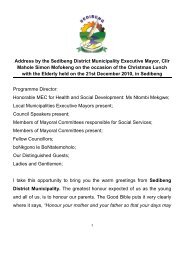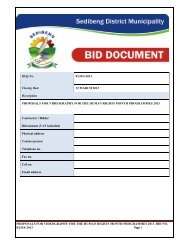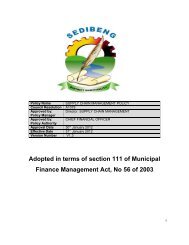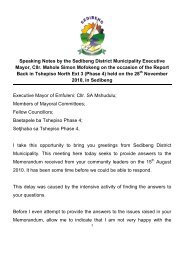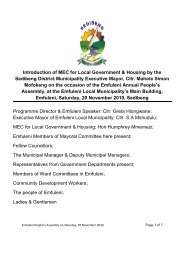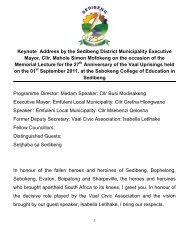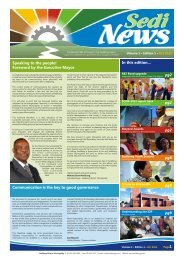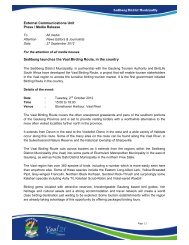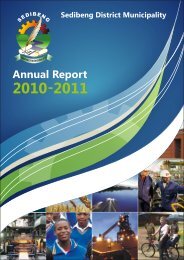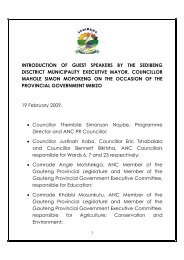Chapter 11 - Sedibeng District Municipality
Chapter 11 - Sedibeng District Municipality
Chapter 11 - Sedibeng District Municipality
Create successful ePaper yourself
Turn your PDF publications into a flip-book with our unique Google optimized e-Paper software.
Commercial agriculture takes up the largest area w ithin Lesedi at approximately<br />
95% of the total land surface, and is dominated by large scale crop (maize, grain,<br />
sorghum, w heat soya and dry beans, ground nuts, sunflow er seeds and vegetables)<br />
and animal production (milk, beef, mutton and lamb, port, eggs and poultry). In<br />
respect of agricultural development, the Gauteng Agricultural Plan (2008) identifies<br />
several Important Agricultural Sites (IAS) and an Agricultural Hub w ithin the study<br />
area. According to the Agricultural Plan, the Agricultural Hubs identified should<br />
become the focus areas for the location and development of all activities (primary and<br />
secondary) related to the agricultural industry – e.g. dow nstream agri-processing,<br />
agricultural villages, incubators, etc. Furthermore, in support of the Hubs, the<br />
Important Agricultural Sites (IAS’s) or the areas falling outside of the boundaries of<br />
the Hubs, should be protected from uses other than for agricultural purposes.<br />
Consequently, the SDF identifies a focus area for agriculture stretching from<br />
Vischkuil/Endicott in the north, southw ards tow ards Balfour. More specifically, in<br />
support of agricultural development and the strategies being implemented by the DLA<br />
and the Gauteng Department of agriculture, the SDF proposes the establishment of<br />
six Area Based Planning (ABP) areas. Essentially, these areas (as proposed by the<br />
Agricultural Plan) are being reserved by the SDF solely for agricultural purposes.<br />
Furthermore, the SDF identifies the strip of land located betw een the R29 and N17<br />
roads as a Development Zone for agricultural-based LED initiatives.<br />
Apart from industrial and agricultural uses, a number of old mine shafts are found<br />
east of Heidelberg and south of Nigel. The most important of these are the old<br />
Witw atersrand/Nigel Gold Mine situated ±3 km south of Jameson Park, and the<br />
vertical shaft in the “Heidelberg Zone of Opportunity” betw een Heidelberg and<br />
Heidelberg x9 (Bergsig).<br />
The Blesbok, Boesman and Suikerbosrandspruits, the Suikerbosrand and Alice<br />
Glockner Nature Reserves, and the ridges represent important environmental<br />
features within the study area. In respect of the SDF and the Lesedi Environmental<br />
Management Framew ork (EMF) (2006), the Blesbokspruit w etlands north of Nigel and<br />
west of Vischkuil/Endicott, and the Suikerbosrand Nature Reserve w est of Heidelberg<br />
represent ecological focus areas. According to the SDF and EMF, these areas should<br />
be conserved and promoted as major eco-tourism and recreational centres.<br />
Grow th and developmental pressure over the last 7 (seven) years has resulted in a<br />
large number of development applications falling outside of the existing urban edge<br />
being approved. Furthermore, several of the existing rural settlement areas w ere<br />
ignored in the delineation of the previous urban edge. These rural settlements<br />
(Devon/Impumelelo, Vischkuil, JamesonPark and Kaydale) play an important function<br />
in the provision of housing opportunities for the rural dw ellers, social facilities and<br />
economic opportunities. Consequently, the SDF proposes that the existing edge be<br />
amended.<br />
In respect of land ow nership, a total of 20 <strong>11</strong>3 registered farms and erven are found<br />
within the <strong>Municipality</strong>, of w hich the majority of the land (92%) comprising these farms<br />
and erven are in private ownership. Significantly though, in terms of the existing<br />
spatial structure, Government-ow ned land is strategically w ell-located to facilitate infill<br />
and densification.<br />
SDM DITP, 2008 to 2013 <strong>11</strong>2 31 Aug 2010



